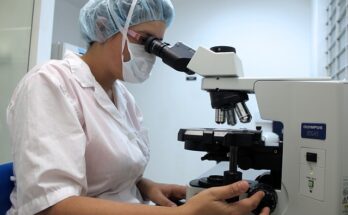The Patient Derived Xenograft (PDX) Models Global Market Report 2024 by The Business Research Company provides market overview across 60+ geographies in the seven regions – Asia-Pacific, Western Europe, Eastern Europe, North America, South America, the Middle East, and Africa, encompassing 27 major global industries. The report presents a comprehensive analysis over a ten-year historic period (2010-2021) and extends its insights into a ten-year forecast period (2023-2033).
Learn More On The Patient Derived Xenograft (PDX) Models Market:
https://www.thebusinessresearchcompany.com/report/patient-derived-xenograft-pdx-models-global-market-report
According to The Business Research Company’s Patient Derived Xenograft (PDX) Models Global Market Report 2024, The patient derived xenograft (PDX) models market size is expected to see rapid growth in the next few years. It will grow to $0.74 billion in 2028 at a compound annual growth rate (CAGR) of 16.1%. The growth in the forecast period can be attributed to demand for personalized medicine, rising in demand for humanized PDX models, growing incidence of cancer, focus on precision oncology, and increasing R&D investment for cancer research. Major trends in the forecast period include technological developments, rising demand for humanized PDX models, collaborative research initiatives, growing investments in cancer research, and increasing focus on immuno-oncology.
The demand for personalized medicine is expected to propel the growth of the patient-derived xenograft (PDX) models market going forward. Personalized medicine involves tailoring medical treatment to each patient’s specific characteristics, considering factors such as genetics, environment, and lifestyle. The demand for personalized medicine is increasing due to advancements in genomic research, which enable tailored treatments based on individual genetic profiles, leading to more effective and targeted healthcare outcomes. Patient-derived xenograft (PDX) models aid personalized medicine by allowing the testing of individual patient tumors to predict treatment responses and tailor therapies accordingly. For instance, in February 2024, according to the Personalized Medicine Coalition (PMC), a US-based nonprofit umbrella organization, in 2023, the FDA approved 16 new personalized treatments for rare diseases, a significant increase from six approvals in 2022. Therefore, the demand for personalized medicine drives the patient-derived xenograft (PDX) models market growth.
Get A Free Sample Of The Report (Includes Graphs And Tables):
https://www.thebusinessresearchcompany.com/sample.aspx?id=17226&type=smp
The patient derived xenograft (PDX) models market covered in this report is segmented –
1) By Type: Mice Models, Rat Models
2) By Technique: Heterotopic Implantation, Orthotropic Implantation
3) By Tumor Type: Gastrointestinal Tumor Models, Lung Tumor Models, Hematological Tumor Models, Gynecological Tumor Models, Respiratory Tumor Models, Urological Tumor Models, Other Tumor Models
4) By Application: Preclinical Drug Development, Precision Medicine, Co-Clinical Trials, Basic Cancer Research
5) By End-User: Academic And Research Organizations, Contract Research Organizations, Pharmaceutical And Biotechnological Companies, Other End-Users
Major companies operating in the patient-derived xenograft (PDX) models market are developing innovative models with in vivo bioluminescence imaging capabilities to enable real-time monitoring of tumor growth. In vivo bioluminescence imaging helps PDX models by enabling non-invasive real-time monitoring of tumor metastasis and treatment responses, enhancing the effectiveness of preclinical research in drug development. For instance, in March 2024, InVitro Research Solutions Private Limited, an India-based Contract Research Organization (CRO), launched an innovative orthotopic model of human glioblastoma in NSG-SGM3 mice by using patient-derived xenografts (PDX) and in vivo bioluminescence imaging. This model aims to enable personalized treatment of glioblastoma, the most common and aggressive type of brain cancer. These models are critical for understanding glioblastoma biology and evaluating new targeted therapies and immunotherapies to improve outcomes.
The patient derived xenograft (pdx) models market report table of contents includes:
1. Executive Summary
- Patient Derived Xenograft (PDX) Models Market Characteristics
- Patient Derived Xenograft (PDX) Models Market Trends And Strategies
- Patient Derived Xenograft (PDX) Models Market – Macro Economic Scenario
- Global Patient Derived Xenograft (PDX) Models Market Size and Growth
.
- Global Patient Derived Xenograft (PDX) Models Market Competitive Benchmarking
- Global Patient Derived Xenograft (PDX) Models Market Competitive Dashboard
- Key Mergers And Acquisitions In The Patient Derived Xenograft (PDX) Models Market
- Patient Derived Xenograft (PDX) Models Market Future Outlook and Potential Analysis
- Appendix
Contact Us:
The Business Research Company
Europe: +44 207 1930 708
Asia: +91 88972 63534
Americas: +1 315 623 0293
Email: [email protected]
Follow Us On:
LinkedIn: https://in.linkedin.com/company/the-business-research-company
Twitter: https://twitter.com/tbrc_info
Facebook: https://www.facebook.com/TheBusinessResearchCompany
YouTube: https://www.youtube.com/channel/UC24_fI0rV8cR5DxlCpgmyFQ
Blog: https://blog.tbrc.info/
Healthcare Blog: https://healthcareresearchreports.com/
Global Market Model: https://www.thebusinessresearchcompany.com/global-market-model




